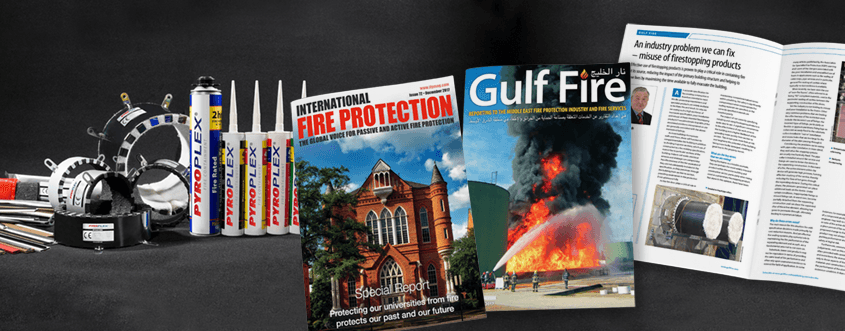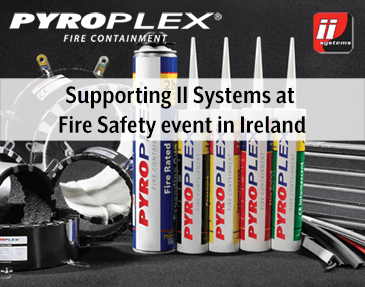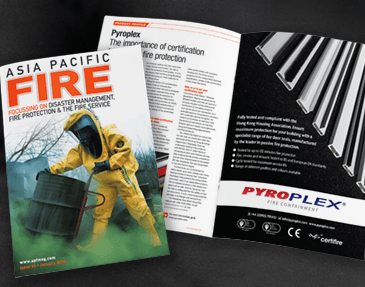The editorial written by Pyroplex Technical Manager, Andy Walsh regarding the critical roles of Fire Containment and Third Party Certification has been featured in the latest December 2017 issue of International Fire Protection magazine. Previously published in Gulf Fire magazine, the authoritative article commentates on the importance of accurate specification and the effective use of fire stopping products.
An industry problem we can fix – misuse of firestopping products

An accurate specification for fire resisting construction is therefore essential to meet this life-protecting requirement and specialist products are widely available to facilitate this end result. So why are we seeing such a high incidence of inaccurate specification, poor installation and misuse of these essential fire stopping products? I would estimate that 80% of the associated problems encountered on site are generally associated with the above-mentioned failings.
As most buildings incorporate walls and floors, these will function to compartmentalise the building in addition to dividing it up into sections, which can, if constructed to a fire resisting specification, restrict fire to particular sections of the building. Indeed, soil waste, electrical services and drainage can compromise the effectiveness of this fire separation if they are not adequately included in the specification, as they penetrate through the building from section to section, providing weaknesses in the protection if not addressed fully.
As the fire door plays a critical role in maintaining compartmentalised zones within a building, fire safety is significantly compromised when inappropriate fire sealing materials are specified, or the correctly specified materials are installed poorly.
The impact of not correctly specifying, installing and using fire stopping products is quite clear to see. A significant compromise in the effectiveness of any work done in the building and a higher likelihood of fire spreading more quickly from section to section. This in turn puts more lives at risk and heightens the potential of the building being more badly damaged, resulting in great loss to the property owner.
What are the key errors that we are seeing?

More recently, we have seen the use of “non-fire foams”, often referred to as being “B3” compliant materials, used in the perimeter sealing of cavities between the supporting construction of fire doors.
Yet the industry is not limiting its misuse and poor installation to fire foams. Other very common problems that are limiting the effectiveness of fire restriction work include: the incorrect use of fixings; the incorrect type of fixings, particularly on flexible or gypsum partitions; fixing lugs on collars not securely fixed to the substrate; collars installed in “cast in” installation and recess holes that are too large for the diameter of the pipe passing through it.
Considering the problems we’re seeing with pipe collar installation in more detail, they and other fire stopping systems are usually mechanically fixed. The pipe collar is installed around the service and fixings are used to fasten the device to the supporting construction. In the event of a fire, the active element within the device will generate high pressure, forming effective crushing of the service, thereby reducing the flow of hot gases through the separating element. During this critical phase, the pressures generated can place additional loads on the device. Under certain conditions, inappropriate fixings or missed fixings can, in worst case, become partially detached from the supporting construction and can shear the expanded char of the active element, allowing hot gases to permeate through, ultimately leading to a premature failure.
Why do these errors occur?

Substitute, lower cost products may not be equivalent in terms of providing the same level of fire performance and often rely upon assessment evidence to extend the field of application. In some instances, for example, where the failure of a component product has occurred, the engineer may wish to increase the volume or ratio of the active element to achieve a given period of fire resistance. This proposed change to the application of the product may not always be implemented, putting performance and in turn, building safety at higher risk.
Furthermore, assessments or engineered judgements, such as this example, are often provided with caveats, limitations and restrictions; the assessment relates only to those aspects of the design, materials and construction that influence the performance of the element under fire resistance condition. It does not purport to be a complete specification ensuring fitness for purpose and long term serviceability. It is also the responsibility of the client to ensure that the element conforms to recognised good practice in all respects and that, with the incorporation of the guidance outlined in the assessment, the element is suitable for its intended purpose.
Such assessments or engineered judgements are opinions based upon the experience of the engineer preparing the report. Whilst there is nothing wrong in using engineered judgements, it is the responsibility of the installer to ensure that the test evidence is suitable and sufficient, and the product is deemed entirely fit for purpose.
The importance of third party certification
There are a number of industry recognised third-party certification schemes available, covering a wide range of fire stopping and fire sealing products. Independent third-party certification schemes formally assure performance, quality, reliability and traceability of fire protection products. Recognised by regulatory authorities worldwide, these schemes are an internationally respected mark of fire safety and some of the most authoritative voices in the industry. The fundamental benefit to any third-party scheme is focused around giving the regulator, specifier, customer and enduser confidence with regard to the stated performance of the product and provides an informed choice when purchasing or selecting such components in the first place.
Choosing a product that carries the mark of a reputable third-party certification body gives assurances as to the overall performance and effectiveness of that product. Using correctly installed certificated products provides a powerful demonstration that due diligences have been served.
Where can installers and specifiers get advice and guidance from?
To sufficiently educate and guide installers and specifiers in the subject of effective fire safety, manufacturers, suppliers and relevant associations such as the Association for Specialist Fire Protection (ASFP) must work together to pool expertise and supply documentation that will alleviate these critical errors in the construction industry.
To that end, Pyroplex has been working with many leading manufacturers including Rawplug, Fischer Fixings, Somat, Split and Hilti to complete a comprehensive guidance document relating to approved fixings suitable for use with Pyroplex 200 and 400 series collars. This document will be made freely available via the Pyroplex website.
Pyroplex also recently commissioned Exova Warringtonfire, its principle fire testing authority, to assist with the design of the specification to test the effective contribution of Pyroplex FR Foam in FD30 installation. The joint between the door frame and the associated supporting construction was set to a gap width of 15mm to the full depth of the timber frame using metallic fixings and non-combustible packers with architraves omitted. The system achieved in excess of 30 minutes’ fire resistance and after 37 minutes, the door leaf failed to maintain fire stability due to sustained flaming of the glazing system.
The Association for Specialist Fire Protection (ASFP) is dedicated to the protection of life, property, the environment and our heritage. It promotes continuous improvement in all aspects of passive fire protection and is a valuable resource for installers and specifiers to make use of.
Working with Government and international standard setting bodies both directly, and via other sector group associations, the ASFP endeavours to increase the quality of installed fire protection within all forms of construction.
The ASFP strives to promote excellence in the design and installation of fire protection products through high quality and technical expertise, by fostering the education and training of all those involved in the development, specification and use of ‘built-in’ passive fire protection.
Both the membership of the ASFP and its remit have broadened in response to the significant changes and challenges that are taking place at many levels within the built environment in terms of technical innovation, regulatory direction, the changing political dimension, evolving commercial forces and geographic expansion of the industry. In so doing, the Association is either responsible for or has had a significant input into the vast majority of guidance documents and standards that exist today across the whole spectrum of the passive fire protection sector.
With many invaluable and educational documents made freely available via the ASFP website and with specialist manufacturers such as Pyroplex working with leading organisations to deliver tangible test results and authoritative guidance, specifiers and installers need to embrace these resources and expertise. Only by doing so can we resolve this entirely fixable problem and elevate the performance of the fire protection market, guarding and even saving more lives in the process.
View the original article on the Gulf Fire Magazine website.
- Fire-safe building - 21st August 2018
- How to incorporate certified passive fire protection for a safer build - 18th June 2018
- Why Passive Fire Protection is Key to the Construction Plan - 12th June 2018



